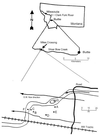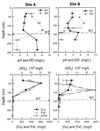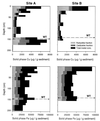Microbiological and geochemical characterization of fluvially deposited sulfidic mine tailings
- PMID: 10103249
- PMCID: PMC91219
- DOI: 10.1128/AEM.65.4.1548-1555.1999
Microbiological and geochemical characterization of fluvially deposited sulfidic mine tailings
Abstract
The fluvial deposition of mine tailings generated from historic mining operations near Butte, Montana, has resulted in substantial surface and shallow groundwater contamination along Silver Bow Creek. Biogeochemical processes in the sediment and underlying hyporheic zone were studied in an attempt to characterize interactions consequential to heavy-metal contamination of shallow groundwater. Sediment cores were extracted and fractionated based on sediment stratification. Subsamples of each fraction were assayed for culturable heterotrophic microbiota, specific microbial guilds involved in metal redox transformations, and both aqueous- and solid-phase geochemistry. Populations of cultivable Fe(III)-reducing bacteria were most prominent in the anoxic, circumneutral pH regions associated with a ferricrete layer or in an oxic zone high in organic carbon and soluble iron. Sulfur- and iron-oxidizing bacteria were distributed in discrete zones throughout the tailings and were often recovered from sections at and below the anoxic groundwater interface. Sulfate-reducing bacteria were also widely distributed in the cores and often occurred in zones overlapping iron and sulfur oxidizers. Sulfate-reducing bacteria were consistently recovered from oxic zones that contained high concentrations of metals in the oxidizable fraction. Altogether, these results suggest a highly varied and complex microbial ecology within a very heterogeneous geochemical environment. Such physical and biological heterogeneity has often been overlooked when remediation strategies for metal contaminated environments are formulated.
Figures






References
-
- American Public Health Association. Phenanthroline method. In: Greenberg A E, Clesceri L S, Eaton A D, editors. Standard methods for the examination of water and wastewater. Washington, D.C: American Public Health Association; 1994. pp. 3-66–3-68.
-
- Benner S G, Smart E W, Moore J N. Metal behavior during surface-groundwater interaction, Silver Bow Creek, Montana. Environ Sci Technol. 1995;29:1789–1795. - PubMed
-
- Brook E J. Particle-size and chemical control of metals in Clark Fork River sediment. Masters thesis. Missoula, Mont: University of Montana; 1988.
-
- Camp, Dresser, and Mckee, Inc. Milltown Reservoir Sediments, Work Plan Scoping Document. Doc. No. 8469-WP-F-RO-010989. Helena, Mont: Montana Department of Health and Environmental Sciences; 1989.
LinkOut - more resources
Full Text Sources

